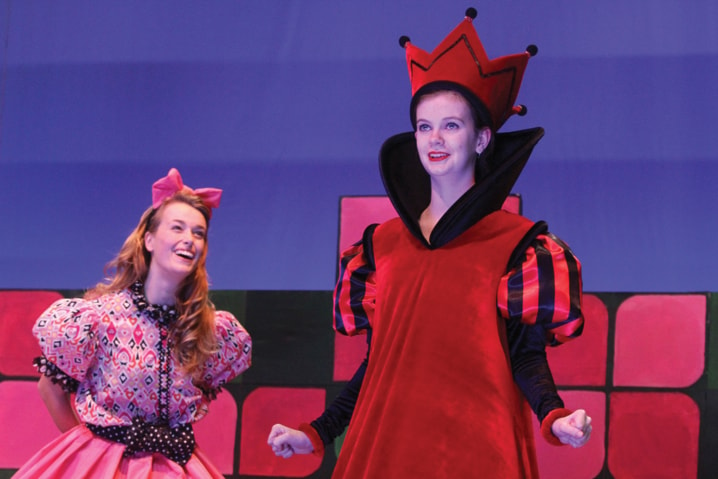Larry Reese recently experienced the kind of topsy-turvy, mind-bending sensation that wouldn’t have been out of character for Lewis Carroll’s literary heroine, Alice.
While walking through a Red Deer College hallway, he heard the déjà vu strains of music he had written as a 20-year-old in the early 1970s drifting from a rehearsal studio.
Theatre Studies students were preparing to stage Alice Through the Looking Glass — the same version of Carroll’s story that was adapted for the stage by Jim DeFelice in 1974, with music composed by a much younger Reese. “It was like opening up a time capsule and finding something that was buried long, long, long ago,” added the now 60-something Reese, who now teaches in the RDC Motion Picture Arts program.
Rather than cringing at the sounds he wrote as a young man, he thought his early compositional effort wasn’t half bad. “It actually brought a tear to my eye because it brought back wonderful memories.”
Reese had no idea when he first scored the play adaptation as a student whether it would have longevity — never mind be reprised four decades down the road. The Red Deer College production of Alice Through the Looking Glass opens on Thursday at the RDC Arts Centre.
He had been studying for his bachelor of music degree in Edmonton when DeFelice, a University of Alberta instructor who had heard Reese perform original songs with his folk-rock band, asked him to write some music for his new stage adaptation of Carroll’s Alice in Wonderland sequel, Through the Looking-Glass, and What Alice Found There.
Being a theatre as well as music buff, Reese was excited to marry his two areas of interest. And he remembers DeFelice encouraging him to take an eclectic approach to his compositions for the play.
This wasn’t difficult for Reese, who was involved at the time with another musical running at Citadel Theatre in Edmonton, and added some Gilbert and Sullivan nuances into his seven songs for Alice.
Since he was also a folk-rock musician, some of those influences can also be heard. “And because I have a sense of humour about things, there are also some homages — some things that are musically humourous” in the tunes, said Reese.
He grew up reading Carroll’s books and identifying with his plucky heroine.
“I liked vicariously going into that world — and reading about the challenges of that world,” he recalled, noting that Alice has to be clever to keep up with, and in some cases outsmart, the bossy adults she meets.
There’s also a subversive darkness to Carroll’s story that Reese believes children appreciate. For instance, the light-hearted, funny duet sung by the Walrus and the Carpenter is actually about eating babies — well, baby oysters.
As a grown-up, Reese appreciates Carroll’s clever writing because it appeals on two levels — to children and to adults.
This imaginative “word play” is what grabbed the interest of RDC Theatre Studies director Lynda Adams, who was happy to be reminded of DeFelice’s play adaptation that had a successful run in Edmonton, Ottawa, Toronto and Vancouver before being shelved for more than 30 years.
Even though the stage play was written only a half-dozen years after Jefferson Airplane’s hallucinogenic White Rabbit song became a chart-topping hit, Adams said it doesn’t contain any hippie references.
It does maintain the whimsical spirit of Carroll’s literary children’s classic, which immortalized quirky characters, such as Tweedle Dee and Tweedle Dum, the White and Red Queens, Humpty Dumpty, the Jabberwocky and the White Knight.
In this sequel, Adams noted, Alice does not go down a rabbit hole, but enters a reverse universe by climbing through the mirror on top of her fireplace. The Looking Glass world is the opposite of Wonderland, drawing on chess rather than playing cards for most references. Adams said, “Alice has to go from being a pawn to being a queen.”
Instead of growing larger or smaller, based on “Eat Me” biscuits or beverages, Alice is bewildered by frequent changes in time and space. She meets characters who must go backwards to advance, and who know what’s going to happen the day after tomorrow.
Adams intends to have fun with the relative sizes of actors with the use of a shadow screen. She is also encouraging her cast of seven second-year acting students to create over-the-top characters who can still react believably in bizarre situations.
“Acting is all about imagination. If you can’t imagine yourself in a situation, then how can you play it?” said the director, who believes that encouraging young people’s fancy is especially important in this electronic age.
Adams stressed that reprising DeFelice’s interpretation of Carroll’s classic story, with Reese’s music, would not have been possible without the skills of Red Deer musician Morgan McKee, who was brought on as the RDC production’s music director.
The talented McKee introduced some necessary musical alterations of his own — including adapting Reese’s band score for a single electronic keyboard.
And Reese is thrilled with the result.
lmichelin@www.reddeeradvocate.com
